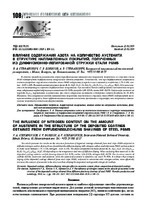| dc.contributor.author | Стефанович, В. А. | |
| dc.contributor.author | Борисов, С. В. | |
| dc.contributor.author | Стефанович, А. В. | |
| dc.coverage.spatial | Минск | ru |
| dc.date.accessioned | 2019-04-05T11:30:06Z | |
| dc.date.available | 2019-04-05T11:30:06Z | |
| dc.date.issued | 2019 | |
| dc.identifier.citation | Стефанович, В. А. Влияние содержания азота на количество аустенита в структуре наплавленных покрытий, полученных из диффузионно-легированой стружки стали Р6М5 = The influence of nitrogen content on the amount of austenite in the structure of the deposited coatings obtained from diffusionsgleichung shavings of steel Р6М5 / В. А. Стефанович, С. В. Борисов, А. В. Стефанович // Литье и металлургия. – 2019. – № 1. – С. 108-111. | ru |
| dc.identifier.uri | https://rep.bntu.by/handle/data/51455 | |
| dc.description.abstract | В статье приведены результаты структурообразования наплавленных покрытий, полученных из стружки стали
Р6М5 подвергнутой диффузионному легированию азотом-углеродом. Установлено, что при диффузионном легировании азотом-углеродом стружечных отходов стали Р6М5 содержание углерода в них изменяется в пределах 1,75–3,14%, азота – 0,43–1,24%. Фазовый состав включает фазы: α-Fe, М6С, Fe3С, (Cr, Fe)2N1–x, Fe3N, Cr0.63 C0.35N0.03, M4(C, N) в зависимости от температуры и времени диффузионного легирования. При наплавке данных материалов в наплавленном покрытии содержится карбидообразующих элементов 8,6–9,3%, углерода 1,04–1,94%, азота 0,08–0,25%. Структура состоит из карбида М23С6, мартенсита и аустенита, при этом содержание аустенита в дендритах может доходить до 70–90%. Показано, что легирование азотом наплавленных покрытий, полученных из стружки стали Р6М5, подвергнутой насыщению азотом-углеродом, более эффективно увеличивает количество аустенита в структуре, чем легирование наплавленных покрытий азотистыми ферросплавами. | ru |
| dc.language.iso | ru | ru |
| dc.publisher | БНТУ | ru |
| dc.title | Влияние содержания азота на количество аустенита в структуре наплавленных покрытий, полученных из диффузионно-легированой стружки стали Р6М5 | ru |
| dc.title.alternative | The influence of nitrogen content on the amount of austenite in the structure of the deposited coatings obtained from diffusionsgleichung shavings of steel Р6М5 | ru |
| dc.type | Article | ru |
| dc.identifier.doi | 10.21122/1683-6065-2019-1-108-111 | |
| local.description.annotation | The article presents the results on the structure formation of deposited coatings obtained from steel chips P6M5 subjected to diffusion nitrogen-carbon doping. It was found that the diffusion doping with nitrogen-carbon steel chip waste P6M5 carbon content in them varies between 1.75–3.14%, nitrogen – 0.43–1.24%. The phase composition includes phases: α-Fe, M6C, Fe3C, (Cr, Fe)2N1–x, Fe3N, Cr0.63C0.35N0.03, M4(C, N) depending on the temperature and time of diffusion doping. When surfacing these materials in the deposited coating contains carbide-forming elements 8,6–9,3%, carbon 1,04–1,94%, nitrogen 0,08–0,25%. The structure consists of carbide M23S6, martensite and austenite, while the content of austenite in dendrites can reach 70–90%. It is shown that nitrogen doping of the deposited coatings obtained from steel chips P6M5, subjected to saturation with nitrogen-carbon, more effectively increases the amount of austenite in the structure than alloying the deposited coatings with nitrogen ferroalloys. | ru |

